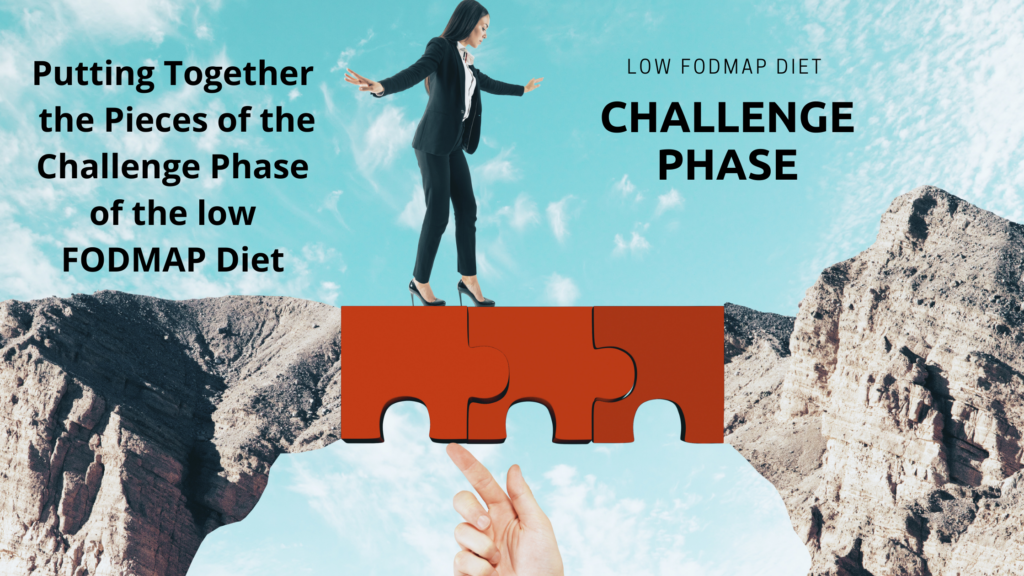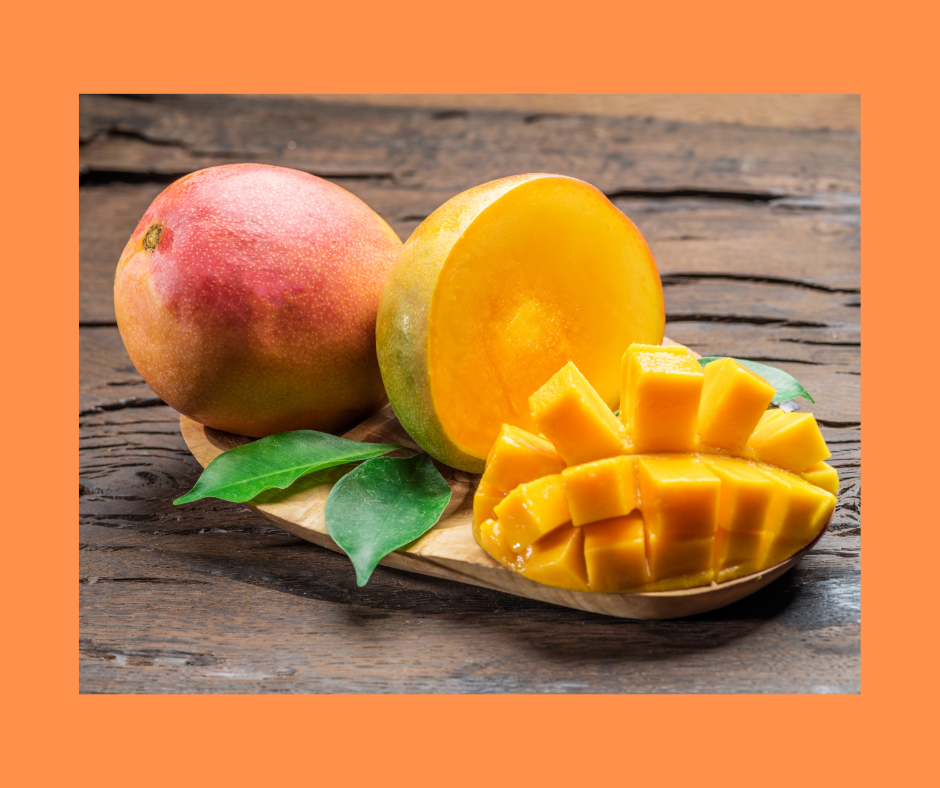How to do the Low FODMAP Challenge Phase

What is the Low FODMAP Challenge Phase
Phases of the Low FODMAP Diet
The challenge phase of the low FODMAP diet is the second of the three phased low FODMAP diet plan used to relieve symptoms common to IBS (irritable bowel syndrome). This second phase is needed to identify the types of carbohydrates that trigger the unpleasant symptoms of IBS.
The challenge phase can also be called the introduction phase. This term challenge aptly describes what happens in this phase – taking time to test or trial certain FODMAP groups against the development of symptoms.
The Monash University developed and described the low FODMAP diet as a 3-phase approach. The phases are the Elimination Phase, the Challenge Phase and the Integration Phase.
The first phase, elimination, is as the name implies. For 2-6 weeks you follow a meal plan restricting higher FODMAP foods. For more information on the elimination phase click here to read “The Secret to Using a Low FODMAP Diet for IBS.”
Your doctor may have handed you a list of foods to avoid. Maybe you downloaded a list from the internet or you purchased the Monash App to better understand the nuances of the diet.
When someone says they are on a low FODMAP diet they are often taking about the first phase. However, they often don’t expand this is just phase one of three.
Either way, experiencing relief while on the elimination phase makes it very attractive to stay there like a potted plant. However, potted plants need several things to be healthy like water and plant food.
The purpose of the low FODMAP elimination diet phase is to assess if following a lowered FODMAP diet stops IBS symptoms like abdominal bloating, distention, and irregular bowel movements.
When this elimination diet works you feel great, however, if you continue avoiding higher FODMAP containing foods, you’re missing out on the very foods needed to ensure a healthy gut.
It’s an irony that higher FODMAP foods provide the very nutrients that the gut needs to maintain a healthy balance of bacteria.
Moving into the Challenge or Introduction Phase
The FODMAP challenge phase is the most important part of this 3-phased diet. The end result is discovering your tolerance to different FODMAPs and reintroducing some yearned for foods back into your life.
Yet success depends on following a methodical plan and this is where the DIY approach can trip you up!
First, let’s look at the ten FODMAP groups to be challenged:
- Lactose
- Fructose
- Fructans with Wheat
- Fructans with Garlic
- Fructans with Onion
- Fructans with Fruit
- Galactooligosaccharides (GOS)
- Sorbitol
- Mannitol
- Fructose + Sorbitol
The reason fructans have four challenges is because of the wide variety of foods that contain fructans and the differences in FODMAP content between these food groups.
If this sounds confusing, it can be! That’s one reason it helps to have a Dietitian guide you through this phase. In addition, your Dietitian can provide you with foods and portions to use for each FODMAP group challenge.
The next step, interpreting the results of the challenge, is where an experienced Dietitian helps you navigate your next step. This is especially useful when the results don’t turn out as expected.
How to Set up a Challenge
Most FODMAP challenge protocols use a three or four consecutive day “test” periods for each one of the ten food groups followed by what is called a “washout” period. The washout period is the time you return to following a low FODMAP meal plan minus the challenge food.
Even if the results of the first challenge show that eating high fructose-containing fruits does not cause digestive symptoms. It is crucial that the person continues to follow the guidelines for a low FODMAP diet during the entire reintroduction or challenge phase.
This may seem harsh but if higher FODMAP foods become part of the daily diet during the challenge phase, there is no way to identify which food or FODMAP group is triggering symptoms.
My preference is a four-day test period since this provides a graduated increase in portion sizes. Here’s an example for the Fructose Challenge:
| Day 1 | ¼ medium mango OR 3 Cherry Tomatoes |
| Day 2 | ½ medium mango OR 4 Cherry Tomatoes |
| Day 3 | ¾ medium mango OR 5 Cherry Tomatoes |
| Day 4 | 1 medium mango OR 6 Cherry Tomatoes |
| Day 5 – 7 | Wash out period – follow low FODMAP guidelines |
I prefer to use a four-day test period since it provides more information on tolerance to various portion sizes. For example, from my personal Fructose challenge I discovered that I can tolerate two teaspoons of honey. However, increasing that by even one additional teaspoon leaves me bloated, gassy, and cramps.
The challenge lets me know I can use honey but should stick to two teaspoons.
Discovering food triggers can take the fear out of eating. Knowing your food triggers can make eating out and social occasions become stress free and enjoyable. Who doesn’t want that!
The time to complete the challenge phase ranges from 6 weeks to 2 months. This depends on a few factors. First, the timing of completing the challenge phase can be reduced if you already know you are lactose intolerant. Also, whether you use the three or a four-day test period can affect the total time for this phase.
However, food intolerance’s can change in our lifetime. There was a time when my lactose intolerance was so severe, I couldn’t tolerate yogurt. Then Greek yogurt became available. The processing of changing regular yogurt to make Greek yogurt reduced the lactose content. This change has allowed me to enjoy Greek yogurt for over a decade now!
What do you do if you “fail” a Challenge?
First, discovering the food or portions that you CAN tolerate is a win! Discovering a food that does cause symptoms is not seen as a failure. This information is part of our personalized diet blueprint. This knowledge, how your body processes certain carbohydrates, is priceless.
Another point, a challenge that does reveal some intolerance’s is not a life sentence.
My recommendation is to do a re-introduction to your challenge food a few months later. Depending on the reasons for your IBS, the gut can restore itself so foods that initiated symptoms are able to be tolerated.
Challenge Phase Recap
- Challenge phase is completed after following the Elimination phase (2-6 weeks)
- During the entire Challenge phase continue to follow the low FODMAP guidelines
- Challenge one of the 10 categories of higher FODMAP containing food at one time for 3 to 4 days with a 3 to 4 days washout or return to a low FODMAP meal plan
- Identifying the portion of food within a category that you can tolerate is one of the goals of the challenge to expand your diet
- Seek out a Registered Dietitian with a working knowledge of the FODMAP phases to help you complete and interpret your results from the challenge
- A challenge resulting in symptoms is not a life sentence to avoid the food or entire food category for life
- The ultimate goal of the challenge phase is to expand the diet with foods and portions shown to not illicit digestive symptoms like gas, bloating, and irregular bowel movements
In Closing …
The Challenge phase of the low FODMAP diet plan is necessary to identify the specific type of FODMAP that is contributing to digestive distress. The ultimate goal of this phase is to provide the information for which foods can be added back to the daily diet. Plus, it can remove anxiety and provide confidence to move forward with expanding the foods in your daily diet.
Want low FODMAP recipes for breakfast? Click Here to sign up for your copy of “Kick your Day Off with 5 Easy-to-Make Breakfast Recipes to Manage IBS Symptoms.” Signing up includes receiving a bi-monthly email from me filled with digestive health information, cutting edge research on IBS, product reviews, upcoming free FODMAP challenges and monthly gut-healthy recipes!

Bonnie Roill is a Registered Dietitian Nutritionist and Gut Health Advocate. She is the owner of B3 Nutrition and since 2010 has maintained a virtual private practice helping women with digestive disorders such as Irritable Bowel Syndrome. As a seasoned Dietitian, with over 40 years experience, Bonnie blends traditional nutrition therapy with functional nutrition practices to create a healthier gut to help with skin, sleep, weight, mood and overall well-being.
Her services include personalized meal plans, functional gut testing, and gut-supporting lifestyle actions to reduce or eliminate unpleasant digestive symptoms. Contact Bonnie for a complimentary, “Create a Happier Gut Today!” phone session and discover how to stop struggling and start thriving with IBS.


